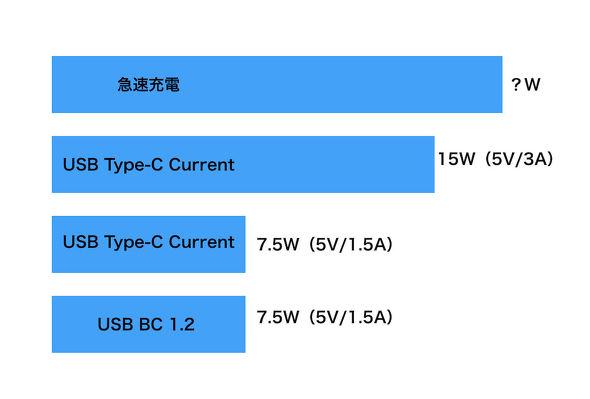Organize the smartphone's "fast charging" standard that is too many to understand: Smartphone x battery comfortable life (page 1/2)
"Quick charging" that can shorten the charging time of smartphones.As the terminal is larger and the battery is large, the response to quick charging is becoming increasingly popular.However, even if you use a quick charging in a word, various standards are messed up, making it difficult for users to grasp the whole picture.Therefore, we organized the minimum information to understand the whole image of quick charging.
What is the output of "not quick charging"?
The definition of the word fast charging is ambiguous.The unit that is a guide to charging speed is "V (bolt)" and "A (ampair)", and "Wat (W)", which combines them.However, it is not strictly determined how many W or more is called quick charging.So let's first consider the standard USB output.The actual charging efficiency depends on the charging control circuit of the cables, chargers, and smartphones used, so the numerical value introduced here is just a theoretical value.
In the first place, the USB (Universal Serial Bus) was born to connect a computer and peripheral device, so it was not initially intended for large -capacity charging.USB 2 formulated in 2000.In 0, theoretically 5V x 0.5a = 2.Can be charged with a maximum output of 5W.0 as standard.1A, the host and the device agreed up to 0.It was a specification where 5A power supply was performed.However, if the data transfer is not a while, the available current is 2..Limited to 5mA.
After that, a standard that is conscious of using it for charging from USB appears."USB BC (USB Battery Charging Specification)" formulated in 2007.In the dawn of the smartphone, "USB BC 1" defined in 2010."2" becomes widespread.Up to 5V / 1 corresponding to this standard.5a (= 7.5W) can be said to be a legacy standard for charging speed that is not rapid.
On the other hand, looking at the smartphone of the summer 2019 model, most of them changed to USB Type-C.Based on this situation, it will be necessary to consider the current standard in the USB Type-C specification.In USB Type-C, there is a charging standard called "Type-C Current", up to 5V / 3A (= 15W) and up to 5V / 1.5a (= 7.There are two patterns of 5W).
速くない充電の基準は「5V/1.5A」と考えておくとよいStrictly speaking, the other USB standards exist, so the story is more complicated.However, here is USB BC 1.2 5V / 1.5a (= 7.Remember the value of 5W) and USB Type-C as one standard.

"USB PD" with up to 13 times the maximum number of w
Although the introduction has become longer, we will finally introduce the high -speed charging standard.First, the USB official standard is the USB PD (USB Power Delivery), which was announced in 2012.It has been formulated based on charging laptops via USB Type-C, and the output of the same standard has been extended to up to 20V / 5A (= 100W).Conventional 7.About 13 compared to 5W.It is three times the value.
However, of course, not all USB PD -compatible devices support 100W.Speaking of smartphones, the upper limit at the moment is about 18W.
Regardless of domestic and foreign manufacturers, recent Android smartphones often support this USB PD.Apple was also supported from "iPhone 8".If you prepare a USB PD -compatible charger and a cable, you will be able to achieve the maximum charging speed corresponding to the terminal.
belkinの「BOOST↑CHARGE USB-C to ライトニングケーブル」(1780円※税別、以下同)はUSB PD対応のLightningケーブルbelkinの「BOOST↑CHARGE USB充電器(27W USB-C)」(3480円)(上)と「BOOST↑CHARGE USB充電器(27W USB-C + 12W USB-A)」(3980円)(下)はUSB PD対応の充電器There are two things to remember when choosing accessories.First, when purchasing a third party, it is safe to choose a product approved by the USB-IF authentication program "Certified USB Charger Program".
The second is that there are two types of USB Type-C, 3A output and 5A output separately from the charging standard.For the reason mentioned above, you don't have to worry too much about charging to your smartphone, but with a 3A output cable, it's only 60W.If you use it for charging a PD compatible notebook PC, you should choose a 5A PD cable.
"Quick Charge" provided by Qualcomm
Apart from the USB standard, there is "Quick Charge" as a charging standard developed by Qualcomm.Current situation, 1.There are multiple versions from 0 to 4+, Quick Charge1.In 0, up to 5V / 2A (= 10W), Quick Charge 2.After 0, it corresponds to the output of up to 18W.
According to the USB charging standard mentioned earlier, the basic voltage was fixed by 5V, except for the USB PD 20V.On the other hand, Quick Charge is characterized by adjusting the voltage.Quick Charge 2.In several stages of 5V, 9V, 12V, etc., Quick Charge 3.0 is 3.Automatically adjust the range such as 6 to 12V.The notation seems to be slightly different depending on the charger manufacturer (the above values refer to the official website of Belkin).
サンワサプライのQuick Charge 3.0対応充電器「ACA-QC46CW」はUSB Type-C ケーブル一体型Android smartphones that support Quick Charge, including LG and Motorola, are also increasing.Note that NTT DOCOMO displays the QUICK Charge standard in paraphrasing the standard of Quick Charge, such as "quick charging 2" or "quick charging 3".
By the way, Quick Charge 4/4+is compatible with USB PD.At the moment, it is not a sufficiently popular standard, but in the future, PD and QC may be used without being aware of both.
メーカーの独自規格も